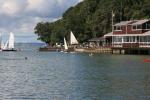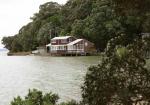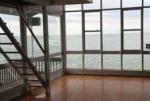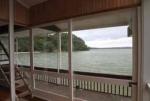French Bay Yacht Club
One of west Auckland’s iconic buildings, the French Bay Yacht Club’s clubhouse is also a testament to community spirit.
The modernist-style building hugging the shoreline of the Manukau Harbour is part of the scenery for those who drive down the hill from Titirangi but it took a huge effort to get it built.
When French Bay Yacht Club was founded in 1956, it operated out of an old building – also on the shoreline – but by 1964, with membership growing, a sub committee was formed to begin planning a new clubhouse.
One of the four people on that committee was local architect Brian Northcott, who was also a keen sailor and was president of the club at one stage. Brian’s son Martin says, “On that committee the planets aligned because there was not only my father but also a structural engineer from Fletchers [Bob Foster], and one of their foremen.”
Martin, who has his own architectural practice in Titirangi, says his father was determined that the clubhouse would be “a building that stood the test of time”.
“If my father hadn’t been involved it would have been a box – but it would have been much cheaper of course,” says Martin.
“My father was a practical thinker and he most likely sat on one of the beach seats on the promenade smoking his pipe with a sketchpad and a 2B pencil on his knee.
“He followed the well-known adage ‘Form follows function’ and he would have been keen to make the structure as simple as possible. I am sure he took some of the design ideas from previous commercial projects he had undertaken and added the necessary design elements to make it a comfortable building.”
About $15,000 was required for the building work – a huge amount of money for the club members, who went on a monumental fundraising drive. All manner of means to raise funds were employed - carnivals, sausage sizzles, garden parties and stalls. Members also built P-class boats at the Boat Show and took
the completed boat around shopping centres to raffle it off.
But most of the money came from bottle drives – in the days when you got several cents a bottle from the recycling depot.
Martin recalls fleets of trucks and cars and trailers going out into the local area, with youngsters raiding any stashes of bottles that they could find.
With funding being such a big issue, there were doubts about proceeding with Brian’s design – a huge project considering it also involved a reclamation, breakwater, launching ramps and stone wall.
“The crux of the design was the clubhouse had to be out on the water purely to leave space for rigging boats on land and to secure the view out to the top mark and around the corner,” says Martin. “I can still recall the fights my father had with the harbour board and all the work he had to do to get it through.”
To keep costs to a minimum, the club decided that members would undertake all the manual work in preparing for the build, including forming the concrete foundations – large reinforced concrete piles anchored into the sea floor – the huge precast floor members and retaining walls.
With the money saved on all this preparatory work, the club was in a position to have the clubhouse finished in 1967.
Martin says his father was able to create a large open plan, lightfilled space in the main part of the clubhouse by using a steel portal frame that sits on a post-tensioned slab with concrete beams beneath that sitting atop concrete piles driven into bedrock. Big sliding doors arranged in a symmetrical fashion embrace the harbour views and open out to the east-facing deck. Tawa floors (40mm) thick also hint at the building’s heritage. Upstairs is the tower or racing loft and a committee room that was used as a discreet social room in the days of tough licensing laws. “Races used to be started up in the racing loft using a sawn-off shotgun firing blanks,” says Martin, who began sailing at the club as a six-year-old and later had a stint as commodore.
He says his father’s original design has been changed slightly over the years with a boatshed being added out the back and the kitchen moved into the corner of the room to make the downstairs space more usable for hireage for social functions such as birthdays and weddings – a big part of the club’s revenue stream.
“The kitchen was in the middle of the building facing the sea because the mothers and wives were a big part of the club,” says Martin. “My father’s idea was that they could see the starts and finishes from the kitchen and look around the corner and see their children out on the course.”
While the clubhouse’s position helps members to keep an eye on events out on the water, it also means the building is exposed to the elements and needs regular maintenance.
Present commodore Matt Hall-Smith says the club has developed a phased programme for renovating the clubhouse and that included replacing the roof recently.
“The building was leaking and we had run several working bees to patch up the roof iron but it had rust holes in it,” Matt says. “We were starting to get water coming down the walls and that put us in a bit of tricky position.”
Luckily, The Trusts came to the rescue with a grant to replace the roof – part of the valuable support they have provided to the club over the years, which has included supplying it with rescue boats.
Dimond recommended Paton roofing to the club as an installer they should bring on board to discuss how to tackle the removal and installation of the roof.
Grant Gilmore, manager of Paton Roofing, says the roughly 30-yearold 0.55 galvanised Dimond Styleline was removed and replaced with Dimond Styleline 0.90 ARX in lengths of up to 12.5m fixed with the help of Aluminium Alutite self drilling screws with profile washers and epdm seals.
“We pretty much replaced like for like, except this time aluminium was used instead of galvanized iron,” says Grant. “Lots of flashings were rusted out and so were the ends of the roof iron over the eaves - the usual places.”
Matt Hall-Smith says as well as a re-roof, the clubhouse is being repainted and having rotten weatherboards replaced.
He says the club is hoping to secure a long-term sponsor so it is not so reliant on hiring out the clubhouse for functions.
Brian Northcott
After enrolling for a degree in architecture, Brian Northcott withdrew without completing the course due to a lack of funds. Instead, he spent years doing draughting work in Wellington before he came to Auckland to work for Rigby Mullan. In order to take up a partnership in the practice he had to return to university and complete his degree. Most of his work with the firm was commercial – the Reckitt & Coleman factory in Rosebank Rd, for example, and jobs for Kerridge Odeon cinemas. He also did residential work, including designing the family home in Titirangi, which, his son Martin says was based on the Bauhaus
aesthetic due to Brian’s modernist training and inclinations. Brian, who is now deceased, worked at Rigby Mullan – which became Rigby James following Tony Mullan’s death – until he retired.





